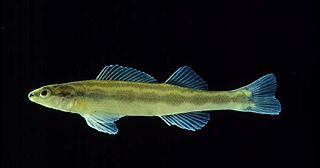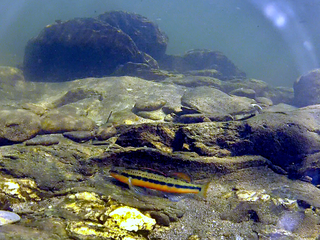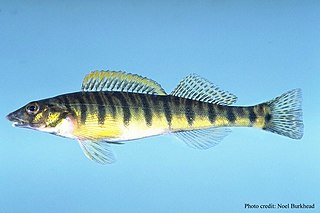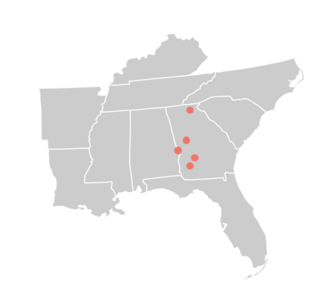
The leopard darter is a species of freshwater ray-finned fish, a darter from the subfamily Etheostomatinae, part of the family Percidae, which also contains the perches, ruffes and pikeperches. It is native to the United States, where it can be found only in the Little River drainage in Oklahoma and Arkansas. Its typical habitat is medium to large streams with rubble and boulder substrate. It feeds on small invertebrates on the riverbed and spawns mainly in March and April. It is threatened by impoundment, habitat loss and runoff from agricultural activities. It has never been a common species and has been listed as a threatened species in the United States since 1978, and the International Union for Conservation of Nature lists it as a "vulnerable species".

The goldline darter is a small species of freshwater ray-finned fish, a darter from the subfamily Etheostomatinae, part of the family Percidae, which also contains the perches, ruffes and pikeperches. It is found in the United States, primarily in the Cahaba River in central Alabama and the Coosa River in Georgia and Alabama. It is a small fish seldom exceeding 3 in (7.6 cm) in length. It is typically found in areas with moderate to swift currents and a water depth of over 2 ft (60 cm), in the main channels of free-flowing rivers with a rock, cobble or boulder base and aquatic plants. It has been federally listed as a threatened species since April 22, 1992, and the International Union for Conservation of Nature has classified its conservation status as being "vulnerable".

The tangerine darter or river slick is a small species of freshwater ray-finned fish, a darter from the subfamily Etheostomatinae, part of the family Percidae, which also contains the perches, ruffes and pikeperches. It is found in the eastern United States. It grows to a length of 4.3 to 7.1 inches, males being bright orange-red while females are yellow. It is insectivorous, picking insect larvae off aquatic plants and the riverbed, and sometimes rolling small stones over to expose prey. It breeds in late spring and early summer, typically in shallow sandy or gravelly riffles. Pollution and habitat degradation may be a problem in parts of its range, however it is a fairly common fish with a wide range and the International Union for Conservation of Nature has classified its conservation status as being of "least concern".

The Roanoke logperch is a species of freshwater ray-finned fish, a darter from the subfamily Etheostomatinae, part of the family Percidae, which also contains the perches, ruffes and pikeperches. It is found in the Roanoke and Chowan drainages in Virginia and North Carolina in the United States. They inhabit low and moderate-gradient streams and rivers in warm, clear water in mostly unsilted gravel and rubble in runs, pools, and riffles. They are primarily insectivorous. This fish is a federally listed endangered species.

The common logperch, sometimes simply known as the logperch, is a species of freshwater ray-finned fish, a darter from the subfamily Etheostomatinae, part of the family Percidae, which also contains the perches, ruffes and pikeperches. Like other logperches, it has the typical vertical barring along the flank and a subterminal mouth.

Percina burtoni, the blotchside logperch or blotchside darter, is a small, endangered species of freshwater ray-finned fish, a darter from the subfamily Etheostomatinae, part of the family Percidae, which also contains the perches, ruffes and pikeperches. It is endemic to the United States and classified as vulnerable on the IUCN Red List.

The bluestripe darter is a species of freshwater ray-finned fish, a darter from the subfamily Etheostomatinae, part of the family Percidae, which also contains the perches, ruffes and pikeperches.

The channel darter is a species of freshwater ray-finned fish, a darter from the subfamily Etheostomatinae, part of the family Percidae, which also contains the perches, ruffes and pikeperches. It is native to North America where it typically occurs in the sandy or gravelly shallows of lakes and in small and medium-sized rivers in riffles over sand, gravel or rock bottoms. It is a small fish ranging from 34 to 72 mm in length, olive brown with darker speckles and sometimes with a dark spot below the eye and dark blotches along the flank. It feeds mostly on insect larvae and other small invertebrates and breeds in small streams. This species is listed as threatened by the Canadian Species at Risk Act (SARA) but overall it has a wide range and numerous sub-populations and the International Union for Conservation of Nature has rated it as a "least concern species".

The dusky darter is a species of freshwater ray-finned fish, a darter from the subfamily Etheostomatinae, part of the family Percidae, which also contains the perches, ruffes and pikeperches. It is found in, but not confined to, both large and small rivers, and shallow creeks, in the eastern, southern, and southeastern United States, particularly the Mississippi River drainage system.

The Mobile logperch is a species of freshwater ray-finned fish, a darter from the subfamily Etheostomatinae, part of the family Percidae, which also contains the perches, ruffes and pikeperches. It is found in the Mobile River basin in Mississippi, Alabama, Tennessee, and Georgia in the southeastern United States. It inhabits clear shallow water and is often associated with Podostemum (riverweed). It grows to about 18 cm (7 in) and is distinguishable from other darters by the distinctive shape of its head and by its pale-yellow base color, with narrow bars on back and sides. It feeds on small invertebrates and breeds between February and May. Lake fish move into small streams to spawn. It is a common fish with a wide range and the International Union for Conservation of Nature has classified its conservation status as being of "least concern".

Percina maculata, the blackside darter, is a species of freshwater ray-finned fish, a darter from the subfamily Etheostomatinae, part of the family Percidae, which also contains the perches, ruffes and pikeperches. It is a widespread inhabitant of streams and rivers in the Mississippi River watershed. Like other darters it prefers rocky riffles and sandy runs, but is tolerant of pools and still water as well. It is one of the 324 fish species found in Tennessee.

The blackbanded darter is a species of freshwater ray-finned fish, a darter from the subfamily Etheostomatinae, part of the family Percidae, which also contains the perches, ruffes and pikeperches. It is native to the river systems of the southeastern United States where it is found in the states of South Carolina, Tennessee, Georgia, Florida, Mississippi, Alabama, and Louisiana. It lives over sandy or gravelly bottoms in smaller rivers and streams and its color varies depending on the different habitats in which it lives. It feeds on small insect larvae and is itself preyed on by larger fish. It spawns between February and June depending on locality. It is a common fish throughout most of its range but is rare in the Altamaha River in Georgia.
The bronze darter is a species of freshwater ray-finned fish, a darter from the subfamily Etheostomatinae, part of the family Percidae, which also contains the perches, ruffes and pikeperches. It is restricted to the Coosa and Tallapoosa River systems in Georgia, Alabama, and southeastern Tennessee in the United States. It feeds on insect larvae and other small invertebrates, and spawns in April and May. It is a common fish within its range and the International Union for Conservation of Nature has classified its conservation status as being of "least concern". However, it is susceptible to environmental disturbance and an ongoing management plan has been put in place to protect its habitat.
Percina phoxocephala, the slenderhead darter, is a species of freshwater ray-finned fish, a darter from the subfamily Etheostomatinae, part of the family Percidae, which also contains the perches, ruffes and pikeperches. It is found in North America in the central Ohio and Mississippi River basins, to northeastern South Dakota and the Lake Winnebago system in Wisconsin, and as far south as the Red River in eastern Oklahoma and northeast Texas, typically in small to medium size rivers. It is a colorful species, with an average length of 6 to 9 centimeters. Males take on a deeper hue during the breeding season. It feeds on insect larvae and other small invertebrates, and spawns between April and June. It is a common fish with a very wide range and the International Union for Conservation of Nature has classified its conservation status as being of "least concern".
The frecklebelly darter is a species of freshwater ray-finned fish, a darter from the subfamily Etheostomatinae, part of the family Percidae, which also contains the perches, ruffes and pikeperches. It primarily occurs in the upper Kentucky and Green river systems of eastern and central Kentucky and north-central Tennessee, being found mostly in the Cumberland Plateau and Highland Rim regions. The fish gets its name from gets its name from the scattered dark spots on its relatively pale underside. However, a possible more telling characteristic of the species is the systematical arrangement of the spots at the base of the tail as well as the continuous stripes down either side of the back. Total population size is unknown but figured to be relatively large. The frecklebelly darter is a benthic darter that relies on invertebrates as its principal diet. The frecklebelly darter can be found primarily in creeks and small rivers with a moderate gradient and a pool/riffle type flow, and spends most of its time in midwater areas of the stream. The major threats of the frecklebelly darter include decimation through perturbations such as strip mining as well as stream channelization projects. The darter is thought to have a high resilience with minimum population doubling time less than 15 months; it is also believed to have low vulnerability. Frecklebelly darter females contain about 100-300 mature ova depending on size. Fish become mature by age 1. Spawning in this darter species involves egg burial where the male mounts the female and deposits eggs in deep depressions created by receptive females.
The saddleback darter is a species of freshwater ray-finned fish, a darter from the subfamily Etheostomatinae, part of the family Percidae, which also contains the perches, ruffes and pikeperches. It is native to the eastern United States. This darter species is widespread, occurring from the Escambia River drainage west to the Mississippi River basin and as far north as the Wabash River historically. Some populations have been reported in the Tennessee River drainage. The saddleback darter is aptly named as it has 5 saddle-like patterns on its dorsum, with the first occurring near the first dorsal fin and the fifth near the caudal penduncle. Adults can attain a maximum size of about 3 inches or 7.8 centimeters. The saddleback darter typically occurs over sand and gravel runs of creeks and small to medium-sized rivers and is sometimes found in very shallow water. This darter's diet consists of invertebrates such as caddisfly larvae, beetles, mayflies, and stoneflies. The saddleback darter deposits eggs over sand and gravel shoals during the spring. This species has an average lifespan between 2 and 3 years.
The sickle darter is a recently identified freshwater ray-finned fish, a darter from the subfamily Etheostomatinae, part of the family Percidae, which also contains the perches, ruffes and pikeperches. It is closely related to a well-known darter, Percina macrocephala. Discovered in 2007 in the upper Tennessee River drainage, the sickle darter is a small ,slender bodied, freshwater and benthopelagic fish that most likely feeds on small crayfish and mayflies since it shares a large mouth and long snout with its sister species. The known distribution of the sickle darter is the upper drainage of the Tennessee River of Tennessee, North Carolina and Virginia. It is distinguished from all other Percina darters except its sister species P. macrocephala by a dark suborbital bar and a black bar subtending a medial black spot on the base of the caudal fin. It stays in mostly rocky, sandy, or silty substrates in clear creeks or small rivers in the Appalachian Mountains. The sickle darter spawns in late winter in gravel shoals. It also has large scales which make it different from macrocephala. It's known to be extirpated from most of its home habitat mainly because of agricultural practices that cause siltation and turbidity which causes most populations of the sickle darter to be widely scattered. But where it is found, it can be observed with regularity. Taking all this into consideration, the sickle darter does not have a formal conservation status under any federal or state law although its closely related species is considered a species of concern by the TWRA. Future management plans should include finding more locations of the sickle darter and decreasing further habitat destruction in known distributions by stating it as a fish of concern by state law.
Percina peltata, the shield darter, is a species of freshwater ray-finned fish, a darter from the subfamily Etheostomatinae, part of the family Percidae, which also contains the perches, ruffes and pikeperches. It is endemic to the eastern United States.

Percina roanoka, the Roanoke darter, is a species of freshwater ray-finned fish, a darter from the subfamily Etheostomatinae, part of the family Percidae, which also contains the perches, ruffes and pikeperches. It isnative to Virginia, West Virginia and North Carolina in the United States. It is found in the Roanoke, Tar, and Neuse river systems, typically in small to medium size rivers. It is a colorful species with an average length of 4.3 centimeters (1.7 in). It feeds on insect larvae and other small invertebrates, and spawns in late May and June. It is a common fish with a very wide range and the International Union for Conservation of Nature has classified its conservation status as being of "least concern".

The Halloween darter is a small freshwater fish native to North America. It is found in Georgia and Alabama in the drainage basin of the Apalachicola River, specifically in the Flint River system and the Chattahoochee River system. It prefers shallow, fast-flowing areas with gravel bottoms in small and medium-sized rivers. It was first described in 2008, having not previously been distinguished from the blackbanded darter (P. nigrofasciata), which occurs in the same watershed. The color is somewhat variable, being generally blackish dorsally, with some individuals having indistinct saddle-like barring. Males have orange and dark lateral striping while females have dark stripes and a yellowish-green belly. At a maximum standard length of 101 mm (4 in), males are slightly larger than females, and both sexes develop distinctive orange barring on the edge of the first dorsal fin during the breeding season.














